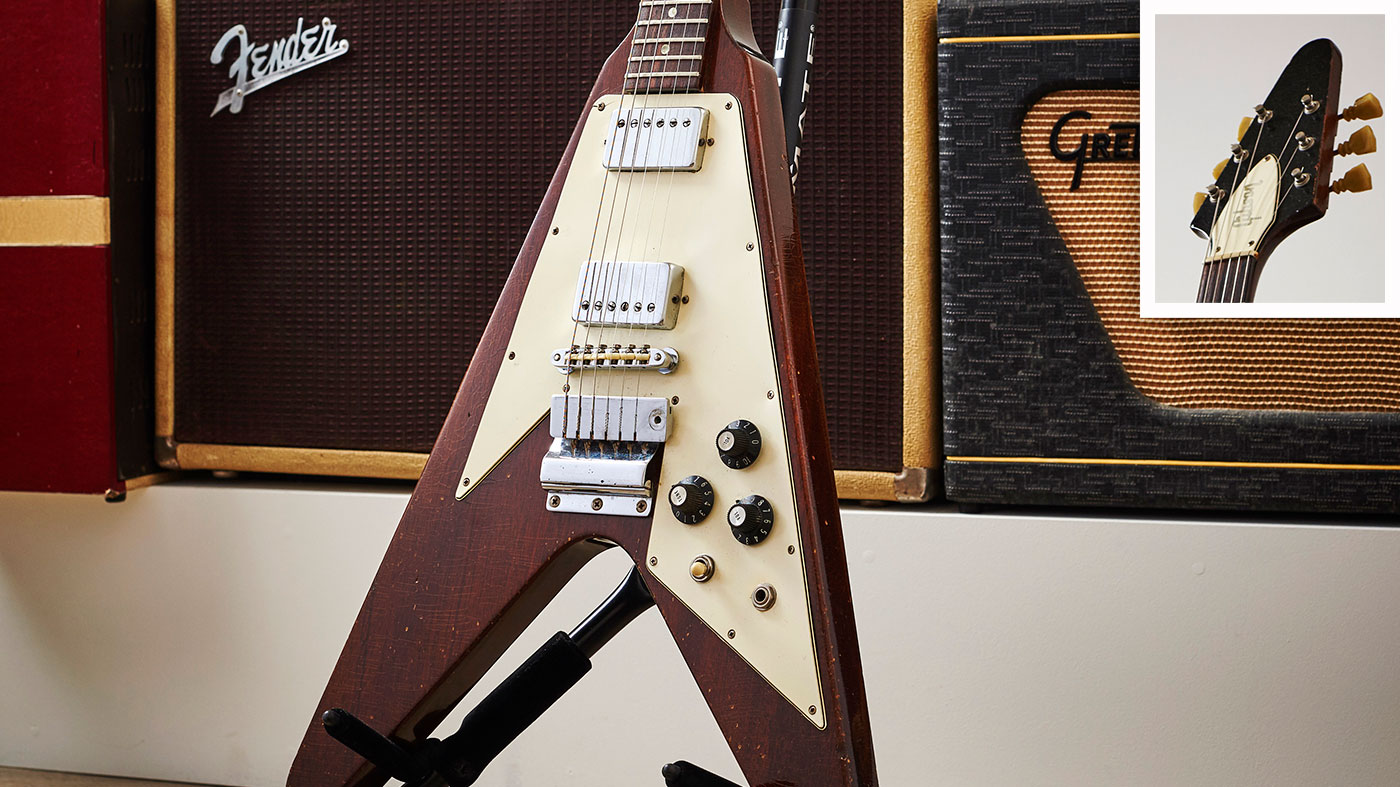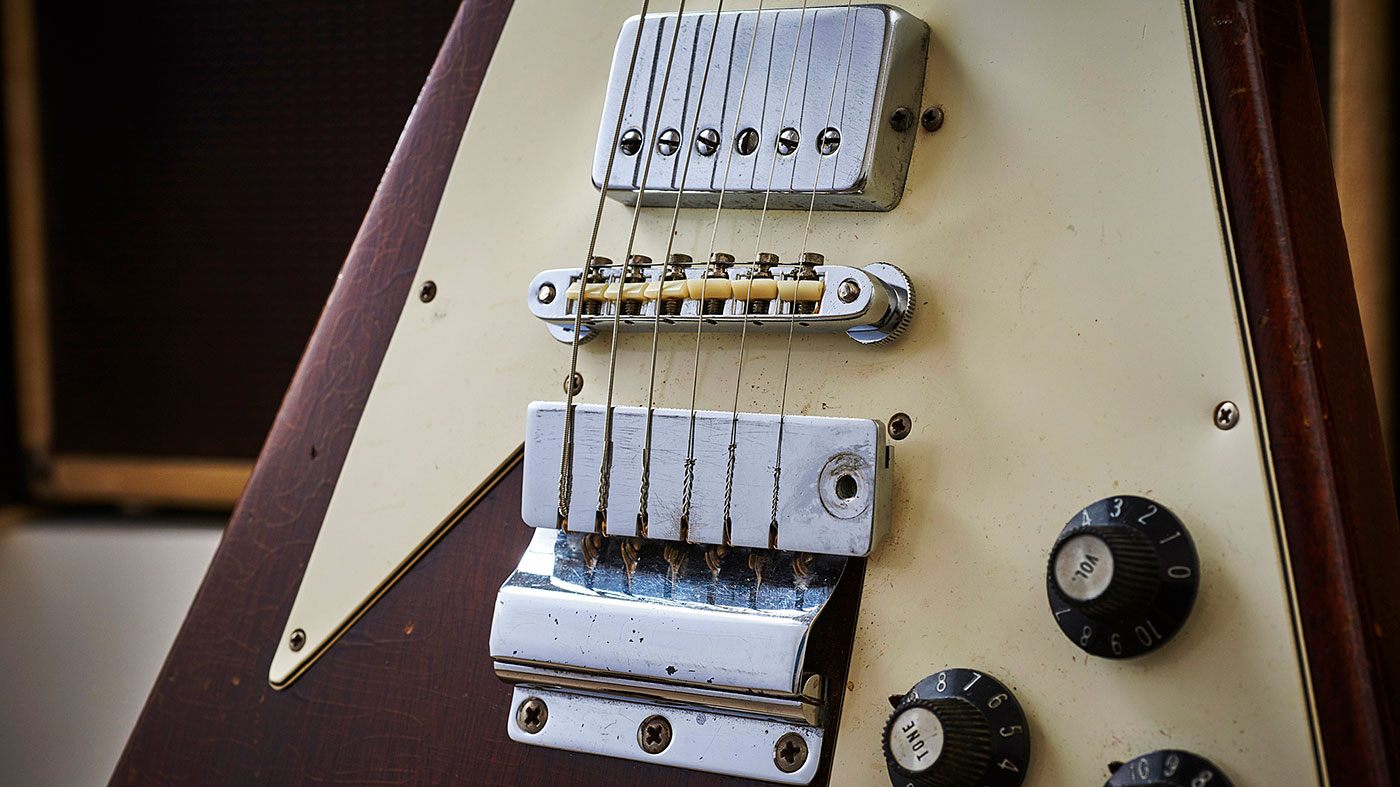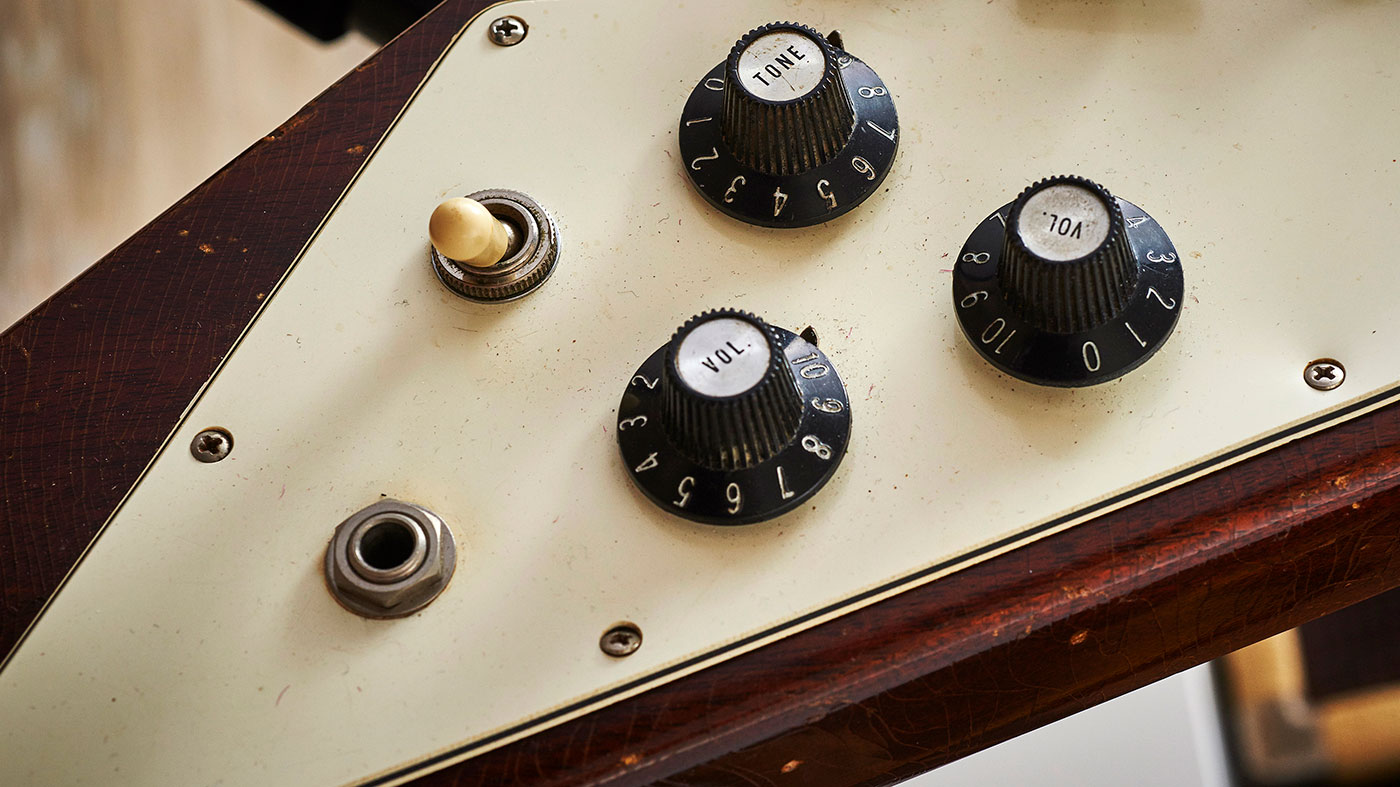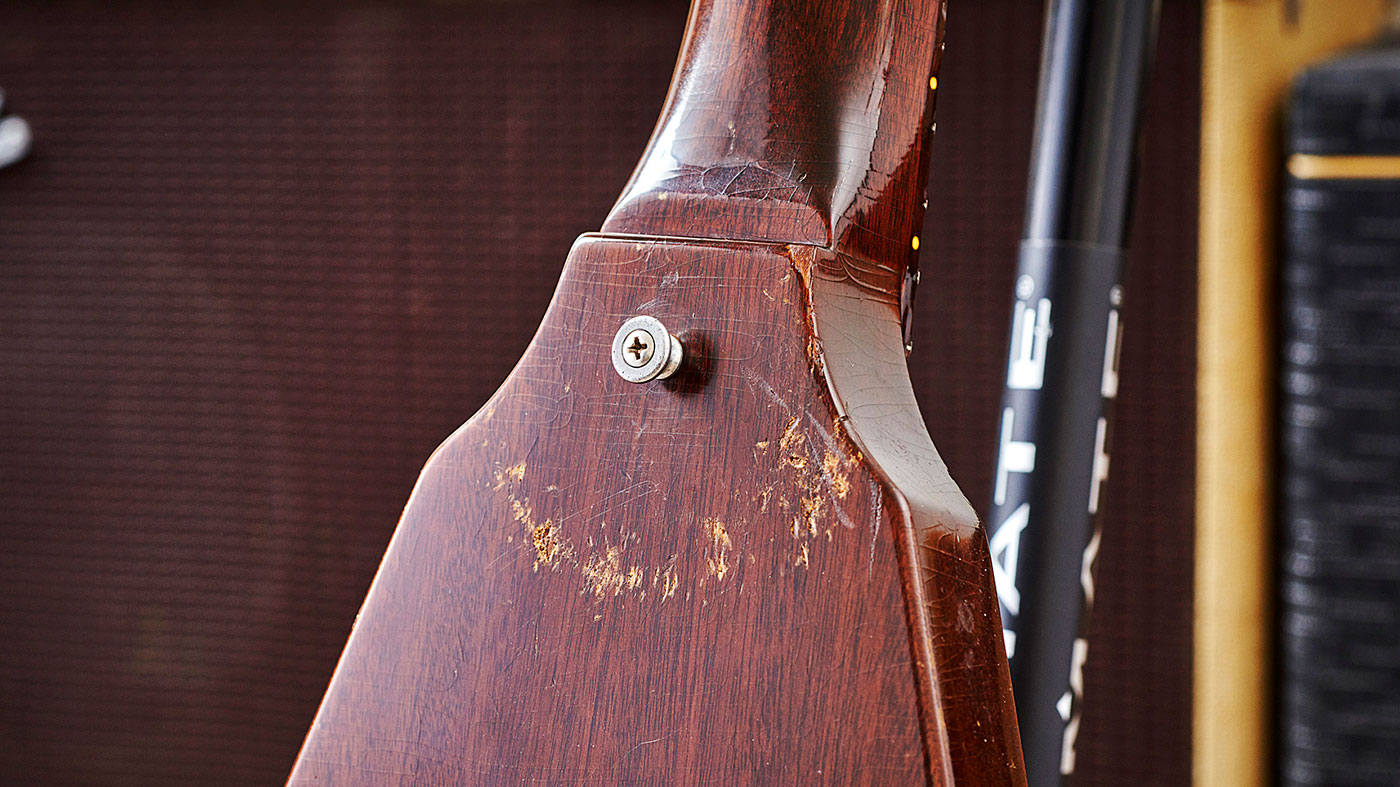Historic hardware: 1969 Gibson Flying V
We uncover the unique charms of an original V

When the Flying V’s original patent appeared in 1957 alongside the Futura/Explorer and Moderne, it might have been argued that Ted McCarty’s heady 50s sci-fi-style brainstorming sessions in the Gibson boardroom were pitching a little too far out into the modernist field.
The Flying V’s function appeared to follow its form, as it eventually took off and found its wings as an archetypal hard rock statement guitar
As it transpired, these guitars were way ahead of their time and took many years to catch on; indeed, the Flying V stuttered, stalled and got off to a few false starts before it really began to fly. As Fender’s Stratocaster and Telecaster models consistently captured the guitar-buying public’s imagination by embodying the modernist design principle ‘form follows function’, the Flying V’s function appeared to follow its form, as it eventually took off and found its wings as an archetypal hard rock statement guitar.
“It’s very much a ‘rock’ guitar,” begins Mike Long, proprietor of ATB Guitars in Cheltenham and temporary custodian of this 1969 Gibson Flying V. “And that’s probably dictated by the shape as much as anything else. I mean, you can’t exactly sit down and play folk music on it. It evokes a certain kind of playing style and when you pick one up, you’re likely to rock out with it. The pickups are very raunchy-sounding mid-60s humbuckers with lots of bite and sustain to them. You won’t see many of these being played through clean Fender amps, but they really come into their own through something like a Marshall stack.”
Although synonymous with Gibson, the Flying V feels immediately very different when compared with its other classic rock guitars. “They feel nothing like a Les Paul,” says Mike. “When people pick up a double-humbucker solidbody, they often expect it to be a bit on the hefty side, but one of the first things you notice when you pick up a Flying V is how light they are. This one-piece Honduran mahogany body is incredibly light, but it’s a really powerful instrument. They’re very easy to use and play for a long time with. This one has brilliant action up and down the fingerboard, and you can access the upper frets very easily. It’s a real joy to play.”

The Underdog
The joys of the Flying V were not always immediately obvious, however, as Mike explains: “It was a very unpopular guitar for Gibson. They made about 100 of the original gold-plated hardware korina [African limba wood] Flying Vs between 1958 and 1959, and they’re extremely rare - and desirable - these days.
“After only a handful of Flying Vs with nickel-plated hardware came out around 1962 to ’63, they were reintroduced again in the late 1960s with chrome-plated hardware, but they didn’t sell very well, either. It was a bit of a disaster, really. It wasn’t until a few key players cottoned on to them in the 70s that they started to gain in popularity. They were reintroduced a couple of more times, before Gibson brought out various reissues, and they steadily grew in popularity.”
The prices of original 1950s Flying Vs now reach well into the six-figure range, while this 1969 Flying V recently sold for £30,000
As the Flying V’s popularity grew, so, too, did the demand for rare, original examples from the earlier periods of production. Subsequently, the prices of original 1950s Flying Vs now reach well into the six-figure range, while this 1969 Flying V recently sold for £30,000.
Want all the hottest music and gear news, reviews, deals, features and more, direct to your inbox? Sign up here.
“1969 Flying Vs are very rare,” says Mike. “Gibson made only 175 Flying Vs throughout the late 60s, in five batches of 35 instruments, and this is possibly the very first guitar of the batch-five walnut Flying Vs. All batch-five Flying Vs had a walnut finish, like this one, but this is the only one known to have a black painted factory- [original] headstock; all known others have a natural walnut-finish headstock. It has a 1968 serial number and was completed in 1969; all batch-five Flying Vs are considered to have been manufactured in 1969 and were released to the public in 1970.”
Although this Flying V reached final assembly in 1969, it appears to have begun life at the Gibson factory years earlier. The vast majority of late-60s Flying Vs share identical pickguards and electronic components, with pots dating to 1966, regardless of shipping year, indicating that they were all allocated parts at the same time for later assembly.
“It appears Gibson did all of the electronics assembly in one go, back in 1966, for the entire five batches,” explains Mike. “It’s likely the pickguards were all put together at the same time - certainly, the parts were sourced at the same time, because they’ve all got ’66 pots, identical pickguards, and pre-‘T-Top’ pickups [‘TTop’ humbuckers appeared in the mid-60s].

“Although the pickguards were assembled in 1966,” Mike continues, “they were most likely wired together at a later date when they finished the guitar off, because the only difference in the electronics between batches appears to be the wiring - it’s often coloured differently throughout the years. Previous batches have multi-coloured wiring [there are combinations of green, yellow, black, white, grey and plain wires], but the wiring in batch-five Flying Vs from 1969 tends to be the same colour: yellow. However, this one does have multi-coloured wiring, so it was probably wired up soon after batch four in 1968, or very early on in ’69.
The neck pickup’s braided wire is soldered to the underside of the pickup casing
“The pickguard itself is a three-ply [white/black/white] plastic type. It isn’t shielded with a separate plate or foil - they put shielding paint on the back instead. If you look inside a Firebird cavity, you’ll see they used the same technique. It’s a silver-coloured conductive paint; they just sprayed it on, and that - they claimed - was the shielding covered. There’s usually a red inspection stamp on the underside of the pickguard, which is the same for every batch. This also supports the theory that they were all assembled together in 1966, when everything was in place, apart from the final wiring. It’s possible they had stacks of Flying V pickguards in the factory from 1966 until 1969, while they were slowly building them and shipping them out.”
The pre-‘T-Top’ humbuckers retained in this 1969 Flying V are a particularly desirable feature and, according to Mike, “these are original patent number sticker [“PATENT NO 2,737,842”] humbuckers from the mid-60s. They’re similar to PAF pickups, but they’re wound with an auto-stop machine and they have slightly different wiring. They’re some of the last of the really, really nice-sounding pickups of the 60s era.
“Because of the unique assembly of the Flying V’s pickguard, the neck pickup’s braided wire is soldered to the underside of the pickup casing. They had to solder the wire there to keep it neatly within the body cavities, so that when they put the pickguard on it didn’t snag. It’s a unique feature you only see on Flying V pickups - you don’t see that on any other guitars. Les Pauls and 335s, for example, had a channel for the neck pickup wires, but Flying V routings are very different.”

In Control
Unlike a majority of Gibson’s doublehumbucker guitars, the early Flying Vs featured three pots/knobs, as opposed to four.
“There are two independent volume controls and one master tone control,” explains Mike. “All three pots are 500k[ohms] CTS brand, dated to ’66 [prefixed 13766]. In fact, all the late-60s Flying Vs I’ve seen have 1966 pot codes - and the tone capacitor is a 0.022uF ceramic disc type. The pickup selector switch and the output jack are both Switchcraft brand, but I think they often had problems fitting the socket, because Flying Vs have a very thin body.
The knobs are often called ‘witch hat’ knobs because of their appearance
“As is the case with this guitar, you often see the shielding paint has been filed away around the socket, and when they finally assembled them, they sometimes found it was a bit difficult to get the tip of the jack all the way in, so on some of them you can see they’ve increased the space of the routing by hand to accommodate it.
“The knobs are often called ‘witch hat’ knobs because of their appearance,” Mike explains. “Although they’re not the most popular style of knobs these days, I think they go really well with the angular styling of the Flying V. Before they brought in the witch hat knobs in 1967, they were using ‘reflector’ knobs [with metal ‘tone’ and ‘volume’ caps]; the first few batches of late-60s Flying Vs mainly had reflector knobs, but they moved over to the witch hat knobs for the last couple of batches.
“The last batch of walnut Flying Vs from ’69 are the most desirable of the five batches because the neck profile is fairly chunky. It’s like a ’68 Gibson profile - it has a bit of meat on it, whereas the others, in batches one to four, tend to be a bit on the skinny side. A lot of the famous V players tended to use instruments from the fifth batch - people like Marc Bolan, Leslie West and Mick Ralphs. Jimi Hendrix also used late-60s Flying Vs from the earlier batches.
“The batch number is buried in the serial number, but more than anything they’re identifiable by their features. Distinctly, all batch fives have a walnut finish and a three-piece neck. The three-piece neck is something that appeared in 1969 after Norlin took over Gibson production; they started to look for ways to economise and one of the things they did was to introduce the three-piece neck because it required thinner pieces of mahogany to make. It’s made with Honduran mahogany and is constructed using a thick centrepiece, with two pieces glued on either side, and that extends from the tip of the headstock to the end of the neck tenon.
“All of the late-60s Flying Vs have the same long neck tenons,” Mike tells us, “but the neck joins changed throughout from batch one to batch five. They went through various neck shelves from short, to a long, rounded shape, to a skinny tapered ‘V’-shape, before going back to the short, rounded shelf again.”

Shine On
Another distinctive feature of the late-60s Vs is their chrome-plated body hardware.
“The late-60s Flying Vs had the shorter version of the Gibson vibrola,” says Mike. “Although it didn’t have a plush ‘leaf and lyre’ Gibson logo engraved cover like the longer one, it did the same job. Those units can really hold their own.
The tuners on this Flying V are Kluson Deluxe branded, but they changed later in ’69 to Gibson Deluxe
“Obviously, you can’t dive-bomb with them, but they’re pretty stable. The Tune-o-matic bridge is also chrome-plated and has nylon saddles. Any 60s Flying V you come across should have nylon saddles - they were all manufactured in that period [1961 to 1971].
“Unlike the vibrola and Tune-o-matic bridge, however, the tuners are not chrome-plated. They were made by Kluson and were always nickel-plated. The tuners on this Flying V are Kluson Deluxe branded, but they changed later in ’69 to Gibson Deluxe. They’re almost identical. It’s very difficult to spot any difference at all, but if you look really closely, you’ll see ‘Gibson’ rather than ‘Kluson’ branded on the back.
“It’s a completely unique guitar and is all original, which is unusual for a Flying V, as many Flying Vs have had mods done to them over the years. Most commonly, it’s Grover tuner replacements and added pickup surrounds, but the cardinal sin of all Flying V mods is adding a stop tailpiece. That is one of the worst things you can do to them. A lot of these poor things have had all sorts of mods done to them and it’s rare to come across one that has survived intact. Thankfully, this one’s a survivor.
“This Flying V model was here at ATB Guitars for about a year and we got very familiar with it in that time. Everybody who came into the showroom loved it - including the local vicar, whose photo with it caused a bit of a stir on Instagram! It had become part of the family and we were quite sad to see it go, but it’s gone to a good home now and I’m sure the new owner is looking after it very well.”
We would like to thank Mike Long of ATB Guitars in Cheltenham
Rod Brakes is a music journalist with an expertise in guitars. Having spent many years at the coalface as a guitar dealer and tech, Rod's more recent work as a writer covering artists, industry pros and gear includes contributions for leading publications and websites such as Guitarist, Total Guitar, Guitar World, Guitar Player and MusicRadar in addition to specialist music books, blogs and social media. He is also a lifelong musician.


